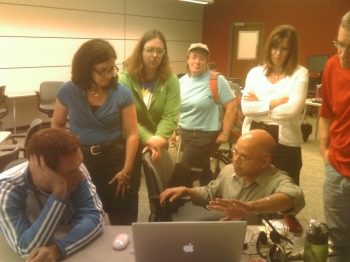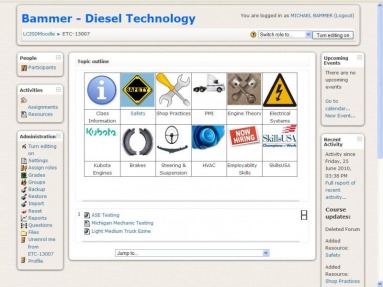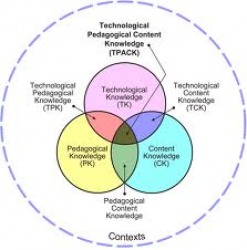Reflection of MAET Cohort 2010

The Experience
This summer was definitely a learning experience. It was fast paced, dynamic and engaging. I have had technology training in the past which gave me a sense of the possibilities of technology uses in education, but failed to give me a full picture of what I could do. For the most part it introduced the technology, but did not incur the pedagogy or relevant content needed for effective implementation. I felt this summer cohort brought the elements together for me to see how I can use technology and why. The wide variety of area content students/teachers and the presentations they made allowed me to see how I could apply given technologies in my own area of content.
Online classes provide flexible way to provide content to students regardless of locations, schedules and time frames. Delivery methods can be unique and challenging with interactive online communication. The three classes I took as part of the certificate program were all online with no face-to-face sessions. They were loaded with content and I learned a great deal of technology and application, but I didn’t get the enthusiasm that comes from the instructor or the dynamics of the class. My research has found that when implementing new technologies (or anything for that matter) the student/teacher has to buy into the relevant value of the concept. When learning online,where are the cheerleaders, where is the sales pitch? My online experience has found the instructor needs to be the facilitator, a cheerleader and a salesperson to get me excited and sell me on using the product. I will have to remember this as I develop my own online classes.
The technology I have learned this summer has been amazing. I have seen applications that I will use and other applications that will become a distant memory. I feel there are appropriate technologies for different content areas, but to stretch a weak technology when there are better ones available seems like we would be focusing on the technology as opposed to the content. That doesn’t I mean I won’t keep exploring new tools. The thing with technology is that tomorrow there will be something new and it may be a better tool. You can not remain static or you will not be operating at your highest potential. This could be too time consuming but it can be manageable. I will read product reviews, chose tools than seem appropriate, and explore them myself. For the good of the cause, I would post my own reviews so that others can learn from my findings.
The flow of ideas and tools to use was virtually endless and a second language emerged. Just as ‘“Google it” has become an expression, so has “Jing it” and if someone were to say,”The file downloads as an MP3, so convert it to an .avi file using zamzar or avs if its bigger than 100MB. Then bring it up in iMovie and edit the sound using audacity. Save it by uploading to youtube or put it in dropbox to share with others.”, I know exactly what they are saying. I have been able to put meaning and relationships to all of these “tech” words that I have heard of in the past.
The review of pedagogues in relationship to technology and content had been a missing element. I know the content and see different technologies, but how do I effectively deliver the lesson? The assignments I have worked on this summer has allowed me to revisit pedagogues and their application to given contexts. The TPACK model put the elements into a context that I can understand. Technology can be a great tool, but its effectiveness depends on the appropriate teaching methods used in light of the content. If these three areas are not taken into account and balanced, student understanding will be diminished and not as strong as it should be.
Creativity was a large part of this program and should be a large part of any program. The Creativity article by Sternberg/Williams reinforced my perception of creativity. My seniors, as a final project, build electric go-carts from scratch for a competition. They have to use the three abilities of creativity, synthetic, analytic, and practical. Most can come up with a great looking concept vehicle, but then they need to analyze what it would require to build such a vehicle. Many initial ideas become rejected as the practicality of building a vehicle that will be able to compete. Students can apply previous knowledge to create a new project and gain a greater understanding of the content.
The Fenman article illustrated the view different people have of the same concept and how the mind works. We think our students understand the concept we taught them, but what they really perceive may not be correct at all. The responses to the Understanding, Understanding video also highlighted the misconceptions that arise from not clearly understanding a concept. It can be hard to visualize information that doesn’t conform to our previous knowledge.
In looking back, I have taken 18 credits in 6 months and at times it feels like my head was opened up and information just poured in. I find ideas resurfacing among the sea of information swirling around up there. I will focus on those I can begin with and bring in other tools as time goes on. I know I need to implement technology into my classroom and I will begin implementing this fall. The next few years may be rough and for the most part I feel like that first year teacher facing the unknown. My favorite engineering expression is, “It works in theory.”. Will it work in real life? Will the student accept the change? Will it encourage them or repel them? Will I have the confidence in the product to sell it? How will my colleagues and administration react?
In the past, I have felt alone in my endeavors without support or guidance. These classes have given me support and guidance, showing me I am not alone and there are others out there working through change as I am. I have a network now that I can turn to, rely on and help in return. With the knowledge, skills and support I have gained through these classes, I feel I can implement a needed change and act as a role model and leader with my school.
The Future

My Techquest project in CEP 812 focused on effective strategies to implement a learning management system, in particular, Moodle. Our intermediate school district supports Moodle and I intend to launch part of my curriculum this fall on Moodle. Effective strategies involve implementing Moodle in stages and modeling to other teachers. I worked with several instructors at the end of the school year, laying the ground work to implement Moodle in their classrooms. I plan to continue working with them as they build their Moodle classroom. Two online resources I have used with Moodle are moodle.org and moodle news.com. Moodle Course Conversion by Ian Wild (2008) is a textbook bible to Moodle conversion. I will also rely on support from our IT department. One of the cool things I learned from Romina Jamieson was how to set up a Moodle site to look neat using a table and links. I have already passed this tip along and have created an instructional paper on how to do it.
I will be implementing more technology into my curriculum. My school year ends over a period of a month as students finish at their home schools. The last week of school I had very few students and as an experiment, I had these students shoot video that demonstrated safe use of shop equipment using a borrowed Flip video camera. It was a successful project and the students seemed to enjoy with it. I felt they finished with a much better understanding of the safety practices involved.
I made a point of visiting with my fellow instructor to show off the camera and the video shot by the students, modeling the value of the technology. I have since ordered two Flip cameras and had one donated. My returning students will shoot video as a safety refresher lesson and those videos will be used to teach the first year students via Moodle. My best resource for these lessons is the knowledge I acquired through the summer cohort. As I worked with Movie Maker, FlipShare, Audacity and various converters, I gained a better understanding of the relationships between these programs. The hands-on, get it done assignments of enabled me to become comfortable in basic video editing. I will continue working with these programs and using them to create effective presentations for my students.
I will continue researching new technologies through sites such as freetech4teachers.com and techlearning.com and professional associations such as ISTE and MACUL. I have come to rely on my cohorts opinions and will solicit their product reviews.
I plan to work with administration and IT to develop meaningful technology professional development. The information I found in my Key Topics research will allow me to develop a plan of effective PD using relevant strategies and applications. One of the biggest teacher complaints is the lack of quality professional development. Several teachers in the building look for other avenues on PD days including calling in. I would like to change this attitude. I feel professional development needs to be relevant to each instructor and by making it relevant will bring effective PD. I will begin by making use of the technology survey conducted last year. It will give me a baseline to determine the technology training the staff needs. I would take it one step further by getting teacher input on what they feel they need and tailor smaller workshops focused on those needs. The resulting PD would be relevant and smaller group size would allow for more individualized instruction.
I began the Educational Technology Master’s Program for a variety of reasons. It seems like most educators get a master’s degree in administration. I like technology and I really didn’t see myself as an administrator, so it seemed a logical choice. My had completed the certificate program a couple of years ago and we wanted to do the cohort together. I also get a bump in salary and as the entire family was paying tuition the extra money was good. However as my eyes opened to the possibilities of technology and I began to see a better picture of the applied practices, I became much more proactive in my learning and the need to share this with my colleagues. It went from something I needed for my own sake to something I wanted to do, then transformed to something I needed to do for the sake of the students and the education system. I honestly didn’t think I would be at this point, but now that it is here, bring it on.

